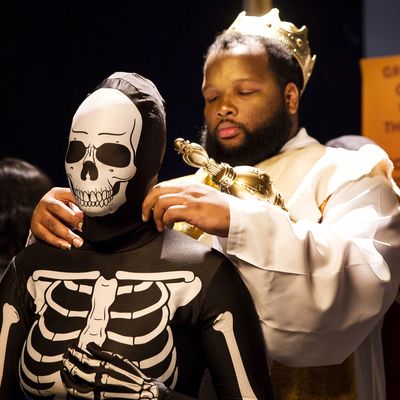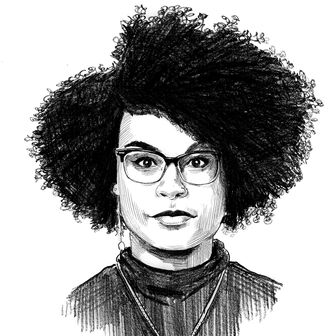
“Shift consciousness” acts as a tagline and guiding principle for artist and creator Terence Nance’s resplendent, bracing new HBO series Random Acts of Flyness. This principle bristles through every facet of the series as Nance and his collaborators flutter through disparate visual forms and tones — stop-motion animation, colorful cartoons, glossy faux infomercials starring Jon Hamm, Afro-surrealism, trippy absurdism, and achingly humane realism — in order to interrogate modern blackness. Yet by the end of its first episode, I was left dazzled but strangely unaffected by its heady splendor. Ultimately, I couldn’t help but ask, whose consciousness is Random Acts of Flyness trying to shift?
It can’t be the culturally voracious young black folks that the show seemingly represents. We understand the crushing effects of white supremacy and the casual violence that accompanies being black in America. It also isn’t necessarily pushing any conversation about blackness forward (except for one important instance), but maybe it shouldn’t have to bear that burden, even as it considers a host of complex subjects ranging from police brutality to sexual fluidity. While Random Acts of Flyness lacks emotional nuance, it is still a rich, endlessly curious work that uses its variety-show model with cunning wit and bravado to constantly rewrite its own parameters.
The best way I can describe Random Acts of Flyness is that it has an Adult Swim posture with HBO gloss. It’s boldy weird, which is most evident in its refusal to adhere to any one aesthetic model. It’s only true through line is an ongoing segment in which Nance, seen in the iPhone-esque vertical frame that’s captured endless examples of police brutality, rides on his bike only to be stopped by an older white cop. Things get violent. But Nance defies the narrative we’d expect, both from how these police confrontations play out in real life and the verisimilitude of how the story is presented visually: His character flies away from the cop, into the open air and away from any potential death. I couldn’t figure out what to make of this. Is it meant to substitute levity and hope for the anger that comes from watching real-life counterparts of this video? Is it meant to be a reprieve from the inherited trauma of white brutality and state-sanctioned violence that black people face? That confusion marks my nagging issue with the show: It’s entertaining and thrilling, but it lacks a strong enough point of view to back up its intellectual rigor and deft curiosity. Choosing to blend so many forms and tonal shifts into a half-hour variety show allows Nance to approach many subjects in startling ways, but without an emotional backbone, the show can feel as scattered as it does entertaining.
The most successful segment in the first episode — bluntly titled “What Are Your Thoughts on Raising Free Black Children?” — comes at the very end, when Nance and compatriot Doreen interview a young bisexual black man named Yeleen. Yeleen talks about his open relationship with his supportive girlfriend, the fluidity of his presentation, and the judgment he received on a date when wore a dress instead of more “masc” presentation. This highly personal conversation interweaves bright cartoon drawings, stop-motion animation with clay-like figures, and a more traditional studio set complete with lush foliage. It’s joyful, buoyant, and, most important, personal in a way the rest of the episode doesn’t quite achieve. Yeleen’s interview doesn’t feel like a black explainer for a white audience, nor a weird-for-weird’s-sake story. It’s a beautifully distinctive segment that complements the story being told, unlike other parts of the episode where visual ingenuity can obscure the more engaging arguments and muddy nuanced emotional dynamics.
Contrast that with the episode’s most glossy and conventional segment, in which Jon Hamm, playing himself in full Don Draper mode, hawks a strange, black balm that is meant to rid people of harmful “white thoughts,” which come in the form of thunderous CGI clouds overhead. When Hamm stops filming the commercial to complain to the black director that he isn’t “white white,” there is definitely humor to be found. “You are here because the people who call themselves white, those victims, they trust you and that beautiful beige face of yours,” the director tells him. It’s an abrasive, self-aware comment about whiteness and white people — especially as it calls attention to who Random Acts of Flyness is designed for, and whether the show deserves that specific burden — but it feels too obvious and superficial in its arguments to leave a lasting impact.
The “Everybody Dies!” segment is the most disturbing and infuriating of the first episode’s offerings. In it, an older black woman named Ripa the Reaper (Tonya Pinkins) takes the form of death itself on a strange, grainy children’s show. Decked in all black, she doesn’t relish her job but is burdened by it as she interacts with young children before ushering them behind a door labeled “death.” Swerving from sugared nursery rhymes to weeping, Rita seemingly represents the role of the black mother who brings children into the world and must immediately reckon with how violence seeps into their lives. But Pinkins’s performance feels miscalculated — performative with emotional turns so sharp they scan as cartoonish — which works against the challenging connections being made about black motherhood and black death. This segment has the same issue plaguing much of Random Acts of Flyness: It’s highly attuned to wide-ranging stylistic experimentation, but lacks the necessary emotional heft and nuance to tackle such topics like the weight of bringing black children into a world that is hostile toward them.
More broadly, this segment puts Random Acts of Flyness along an arc that includes recent works like Atlanta, Sorry to Bother You, and even Get Out to a certain degree. Each braids Afro-Surrealism into its approach to argue that horror is inherent to the black experience. Yet Random Acts of Flyness feels the most unique when it tips toward exuberance rather than detailing the everyday potential for violence that black people face. Even then, the series feels half-formed, too emotionally thin and intellectually blunt to reach the potential it demonstrates. To do so, Nance and his collaborators will have to figure out more to say and, most important, how they want their audience to feel about it.





